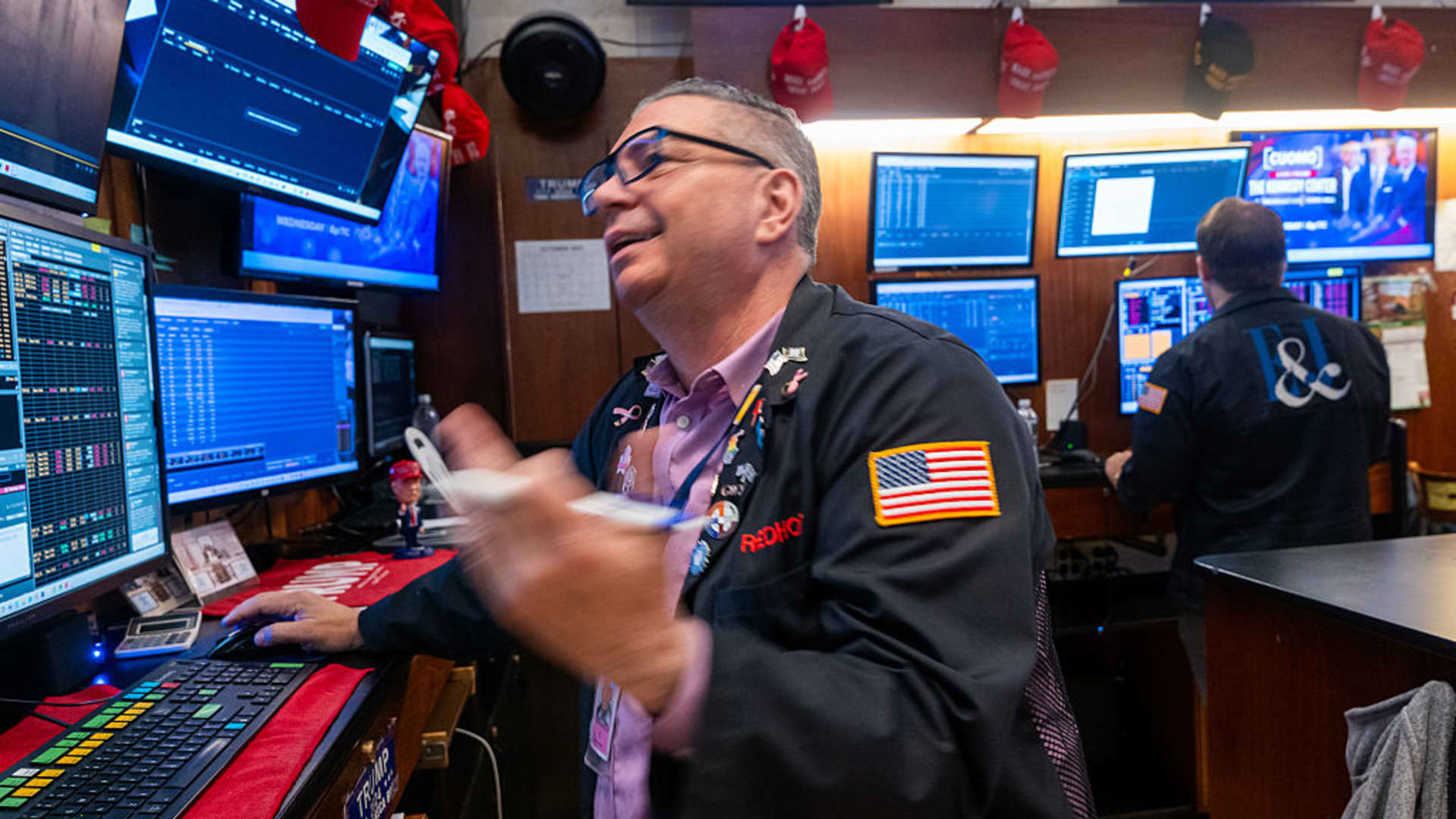Two-plus decades have passed since Will Power last raced a production-based sports car in Australia’s Bathurst 24 Hour in 2003 in a Porsche 996.
The two-time NTT INDYCAR SERIES champion said he has looked for the right opportunity…

Two-plus decades have passed since Will Power last raced a production-based sports car in Australia’s Bathurst 24 Hour in 2003 in a Porsche 996.
The two-time NTT INDYCAR SERIES champion said he has looked for the right opportunity…

Traders work on the floor of the New York Stock Exchange (NYSE) on October 13, 2025, in New York City.
Spencer Platt | Getty Images
Stocks fell Thursday, giving up earlier gains, led by declines in bank stocks on worries about bad loans. Traders also juggled persistent trade tensions and an ongoing U.S. government shutdown.
The Dow Jones Industrial Average lost 411 points, or 0.9%, after gaining 170 points at one point. The S&P 500 traded nearly 1% lower, giving up a 0.6% gain at the highs of the session. The Nasdaq Composite fell 0.9%.
Regional banks Zions and Western Alliance fell to their lows of the day as indexes rolled over. Zions plunged 12% after taking a sizable charge because of bad loans to a couple borrowers. Western Alliance dropped 10% after alleging a borrower had committed fraud.
“The market is just really skittish about credit-related losses,” Jed Ellerbroek, portfolio manager at Argent Capital Management, told CNBC. “The market is not very happy about [the regional banks’ comments], so most small-cap financials, banks are down today.”
The banking industry has been on edge lately following the bankruptcies of two auto industry-related companies that have raised concerns about loose lending practices, especially in the opaque private credit market.
“When you see one cockroach, there are probably more,” JPMorgan CEO Jamie Dimon said on the bank’s earnings conference call earlier this week, related to the collapse of First Brands and Tricolor Holdings. Jefferies, which has some exposure to First Brands, shed 10% on Thursday, bringing its losses for the month to 25%.
Zions, 1 day
The decline in stocks coincided with a jump in the Cboe Volatility Index and moves lower in bond yields and the U.S. dollar. The Vix spiked to its highest since May, while the 10-year Treasury yield fell and broke below 4%. The U.S. dollar index lost 0.4% and hit its lows of the session midday.
Trade tensions between China and the U.S. recently increased, adding to volatility on Wall Street.
President Donald Trump last week threatened to place an additional 100% tariff on any goods coming from China in response to the country’s new export controls on rare earth minerals. The trade tone softened over subsequent days, but tensions increased again Tuesday, when Trump on threatened China with a cooking oil trade ban.
“The Trump administration desires to influence and control a lot more things than past administrations have … so they’re constantly jolting the market in unexpected ways,” Ellerbroek said. “That’s going to continue, and investors just have to kind of accept that as a new fact of life and be on their toes.”
Investors are also keeping a watchful eye as the U.S. government shutdown continues for a third week. The stoppage has led to an indefinite shutdown of crucial economic data releases from federal agencies.

By Lukas I. Alpert
After years of fighting scams and fraud, the music-streaming company announced it is joining forces with three major music labels to develop AI products that can help artists
Spotify says it works hard to…

A research team in Germany has achieved a stunning theoretical breakthrough that could reshape one of physics’ oldest foundations after demonstrating that the no longer holds true for objects on the atomic scale.
Their findings, made by…

By Vivien Lou Chen
Treasury Department data does not reflect how much hedge funds domiciled in the Cayman Islands are dominating the so-called basis trade, according to a team at the Federal Reserve.
Data from the U.S. Treasury Department is failing to capture Cayman Island hedge-fund exposures to Treasury securities.
Key Treasury Department data is massively underreporting the amount of U.S. government debt held by hedge funds registered and incorporated in the Cayman Islands, and is failing to reflect their heavy reliance on a controversial leveraged trade that has repeatedly alarmed regulators.
In a note released on Wednesday, a team at the Federal Reserve found that U.S. Treasury International Capital data appears to be “severely” undercounting the amount of Treasurys held by those hedge funds, to the tune of about $1.4 trillion as of the end of the 2024. In addition, the Fed team concluded that TIC data is not capturing just how much Cayman-domiciled hedge funds are dominating positions in the so-called basis trade.
Since at least 2018, U.S. regulators have periodically expressed alarm over the possibility that the basis trade could trigger wider financial instability during market downturns. The Treasury Department’s press office did not immediately respond to a request for comment on Thursday. The U.S. government has been in a partial shutdown since Oct. 1.
The basis trade uses leverage to arbitrage the price differences between Treasury futures and cash Treasurys. It involves simultaneously buying a Treasury cash position and selling a Treasury futures position, and financing the trade by borrowing in the repo market to provide leverage. The unwinding of the basis trade was seen as a likely contributor to Treasury-market instability in March 2020, and the risk of a possible repeat following hedge funds’ increased reliance on leverage drew scrutiny from the Fed’s board of governors and the Treasury in 2023.Read: Hedge funds’ use of leveraged Treasury trades needs ‘diligent monitoring,’ Fed paper says
TIC data is the main source of U.S. data on cross-border securities and banking. It is used by policymakers, investors and researchers to understand the catalysts and impacts of cross-border flows and asset allocations among various countries and investor types.
The severe underreporting of Cayman-domiciled funds’ Treasurys holdings presents “a major impediment for researchers, policymakers, and other data users seeking to analyze cross-border flows and their effects on the U.S. economy and financial markets,” according to the note written by Daniel Barth, principal economist for the Federal Reserve Board; Daniel Beltran, a deputy associate director; Maria Perozek, chief of the board’s Flow of Funds section; and others. The authors estimate that holdings of Treasury securities of Cayman-domiciled hedge funds stood at $1.85 trillion by the end of 2024, having climbed by $1 trillion since 2022.
“Our findings suggest that Cayman Islands hedge funds are, increasingly, the marginal foreign buyers of U.S. Treasury notes and bonds,” the authors said. After factoring in an estimated underreporting of roughly $1.4 trillion, they wrote, the Cayman Islands “is in fact the largest foreign holder of U.S. Treasury securities – holding significantly more than China, Japan, and the United Kingdom,” which currently rank as the three largest holders.
Hedge funds domiciled in the Cayman Islands held an estimated $1.85 trillion in Treasurys at the end of 2024, according to a note from the Federal Reserve.
Meanwhile, the gap between what’s being reported in the Treasury Department’s TIC data versus what’s reported to the Securities and Exchange Commission has widened to almost $1.4 trillion as of the end of last year. “TIC data on Cayman Islands holdings of Treasuries do not appear to be picking up the Treasury transactions associated with the basis trade activity” that can be seen on the hedge funds’ filings to the SEC, according to the Fed note.
While this roughly $1.4 trillion gap is not solely attributable to the basis trade, “the puzzling disconnect between the TIC and [SEC’s] Form PF data on Cayman Islands’ holdings of U.S. Treasuries is under active investigation,” Barth and the other authors wrote.
The amount of Treasurys held by hedge funds domiciled in the Cayman Islands is far greater than what is being reported in the Treasury Department’s TIC data, according to a note from the Federal Reserve.
On Thursday, U.S. government debt rallied, sending Treasury yields lower across the board, as investors digested a mix of worries about trade tensions between the U.S. and China, the partial government shutdown, and bad loans in the bank industry. Separately, U.S. stocks DJIA SPX COMP were falling in afternoon trading.
-Vivien Lou Chen
This content was created by MarketWatch, which is operated by Dow Jones & Co. MarketWatch is published independently from Dow Jones Newswires and The Wall Street Journal.
(END) Dow Jones Newswires
10-16-25 1424ET
Copyright (c) 2025 Dow Jones & Company, Inc.

Al Pacino has paid tribute to the his co-star and ex-romantic partner Diane Keaton who died last week.
The 85-year-old actor had been filming in Paris and reportedly needed some time to put together his thoughts and feelings on Keaton, who died of…

Stay informed with free updates
Simply sign up to the Artificial intelligence myFT Digest — delivered directly to your inbox.
One odd thing about AI equipment is that it’s very expensive to buy and very cheap to rent.
Want an Nvidia B200 GPU…

Fujifilm has announced an update to its Instax Mini LiPlay that first launched in 2019. The new Instax Mini LiPlay Plus offers similar functionality as the original with the ability to snap digital photos that can be immediately printed on the…

 EPA
EPAIsrael’s prime minister has told a memorial for victims of the Hamas-led attack on 7 October 2023 that he is “determined” to secure the return of the dead…